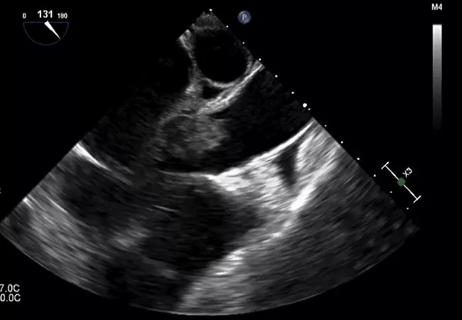ATHOS-3 subgroup analyses reveal compelling benefits

In December 2017, human synthetic angiotensin II was FDA-approved for use in septic and other distributive shock. The findings from Angiotensin II in High Output Shock (ATHOS-3), a global trial involving 75 ICUs, was instrumental in getting the drug through on an accelerated basis. Cleveland Clinic’s Ashish Khanna, MD, served as principal investigator for the trial, which supported angiotensin II as a safe and effective therapy.
Advertisement
Cleveland Clinic is a non-profit academic medical center. Advertising on our site helps support our mission. We do not endorse non-Cleveland Clinic products or services. Policy
Since that time, ongoing analysis from this study has revealed superior outcomes for patients in certain subgroups, supporting decision-making that is informed by patient history, labs and responses to standard first-, second- and third-line vasopressor therapies. Chest, Intensive Care Medicine, Critical Care Medicine and Current Opinion in Critical Care recently published articles by Dr. Khanna and his team, highlighting these newer subgroup findings and suggesting guideline changes that reflect this deeper understanding.
Mortality rates in the U.S. are 15-25 percent for patients with sepsis, and about 40 percent for those who progress to septic shock. The consensus on treatment is early antibiotics, aggressive resuscitation and initiation of vasoactive agents, if needed, to augment hemodynamics. “But,” Dr. Khanna notes, “guidance on managing refractory septic shock is sparse.”
He continues, “The Surviving Sepsis Campaign (SSC) guidelines include norepinephrine as first-line (with epinephrine as an alternative or additive), vasopressin as second, and dobutamine as third (typically where there is additional cardiogenic shock), but what if the patient is non-responsive to the second- or third-line agents?” The answer is typically more norepinephrine and epinephrine. Yet there is increasing evidence that favors limiting high-dose catecholamine use to avoid downstream morbidities. Vasopressin, typically used as second-line agent, is a non-catecholamine option, but its response benefit may be limited to only about 50 percent of patients.
Advertisement
The ATHOS-3 study investigated whether predefined hemodynamic goals and a dose reduction in norepinephrine, epinephrine, vasopressin or dobutamine can be achieved with angiotensin II. Dr. Khanna suggests that a multimodal approach to vasopressor therapy, first of all, is logical.
“During sepsis, pulmonary endothelial dysfunction can decrease angiotensin converting enzyme (ACE) activity, subsequently reducing angiotensin II levels and increasing mortality odds,” he says. “Supplying exogenous angiotensin II makes physiological sense. If the body naturally has three legs to the stool needed to maintain healthy blood pressure, we truly need to provide all three legs — epinephrine/norepinephrine, vasopressin and angiotensin II — early on, versus loading our patients with more and more norepinephrine, then vasopressin, and once these options are exhausted, turning to a third agent.”
ATHOS-3 supplied the evidence to support this logic. With this adjunct use of angiotensin II, the number of patients who reached a target mean arterial pressure (MAP) of 75 mmHg within three hours was 69.9 percent vs. 23.4 percent in the placebo group. Mean cardiovascular SOFA scores at 48 hours were also significantly lower in the angiotensin II group. Survival rate at 28 days was better than the placebo group, though not statistically significant.
Subsequent subgroup analysis supports a stratified, case-by-case approach to drug choices. For example, in patients who had more severe illness and a relative deficiency of intrinsic angiotensin II, receiving angiotensin II led to a mortality rate of 51.9 percent versus 70.8 percent in the placebo group.
Advertisement
“If the ratio of intrinsic angiotensin II to angiotensin I was low due to genetics, medications or disease process like septic shock itself, patients had a better hemodynamic profile and better survival odds with exogenous angiotensin II than those who had a low ratio and received placebo,” Dr. Khanna explains.
In patients who developed acute kidney injury, administration of angiotensin II resulted in superior hemodynamics, earlier liberation from renal replacement therapy and higher survival rate.
Separately, important outcomes from Dr. Khanna’s concurrent research also support raising the target MAP for critically ill ICU patients from the current recommendation of 65 mmHg to prevent downstream morbidities.
“The cost of angiotensin II is nearly tenfold that of the other agents we use,” Dr. Khanna laments. “However, we have found a way and a reason to use angiotensin II in a very cost-effective way because patients tend to be either early responders or non-responders.”
Trial participants who were given a low dosage of 5 ng/kg/min and responded within about 30 minutes after initiation of the drug had a significantly lower all-cause mortality rate at 28 days versus those needing higher doses.
“If they don’t respond within, say, a couple of hours and you are escalating to 80 ng/kg/min or higher doses, they are unlikely to see a benefit.”
Dr. Khanna foresees a future where phenotyping will identify patients who are best candidates for angiotensin II.
“Hopefully we will be able to screen people for angiotensin I and II levels as markers of intrinsic disease and we can tailor a specific treatment to what they are lacking in,” he says.
Advertisement
“Angiotensin II represents a new weapon in our vasopressor armamentarium,” he concludes. “Early multimodal treatment that incorporates this agent limits the potential toxicities of monotherapy. But we need to take it case by case, using the appropriate vasopressor in the appropriate patient at the appropriate time.”
Ashish K. Khanna, MD, FCCP, FCCM, is a staff intensivist in the surgical ICU and Vice-Chief for Research in the Center for Critical Care at Cleveland Clinic. He also is an assistant professor at Cleveland Clinic Lerner College of Medicine.
Advertisement
Advertisement

Not if they meet at least one criterion for presumptive evidence of immunity

Essential prescribing tips for patients with sulfonamide allergies

Confounding symptoms and a complex medical history prove diagnostically challenging

An updated review of risk factors, management and treatment considerations

OMT may be right for some with Graves’ eye disease

Perserverance may depend on several specifics, including medication type, insurance coverage and medium-term weight loss

Abstinence from combustibles, dependence on vaping

An historical view of the disease